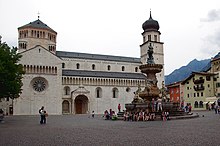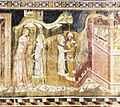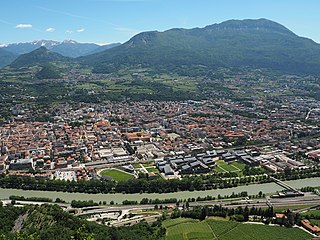
Trento, also known in English as Trent, is a city on the Adige River in Trentino-Alto Adige/Südtirol in Italy. It is the capital of the autonomous province of Trento. In the 16th century, the city was the location of the Council of Trent. Formerly part of Austria and Austria-Hungary, it was annexed by Italy in 1919. With 118,142 inhabitants, Trento is the third largest Italian city in the Alps and second largest in the historical region of Tyrol.
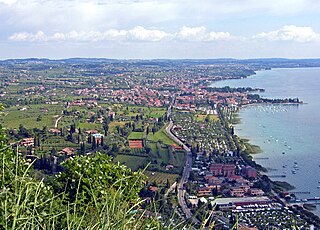
Garda is a town and comune on the shore of Lake Garda, in the province of Verona, Veneto, northeastern Italy.

Bologna Cathedral, dedicated to Saint Peter, is the cathedral of Bologna in Italy, and the seat and the metropolitan cathedral of the Archbishop of Bologna. Most of the present building dates from the 17th century, with a few parts from the late 16th century.

The Basilica of Santa Maria Maggiore is a major church in the upper town of Bergamo, Northern Italy.

The Duomo of Monza, often known in English as Monza Cathedral, is the main religious building of Monza, Italy. Unlike most duomi, it is not in fact a cathedral, as Monza has always been part of the Diocese of Milan, but is in the charge of an archpriest who has the right to certain episcopal vestments including the mitre and the ring. The church is also known as the Basilica of San Giovanni Battista from its dedication to John the Baptist.
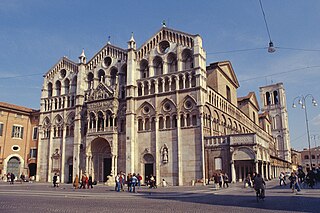
Ferrara Cathedral is a Roman Catholic cathedral and minor basilica in Ferrara, Northern Italy. Dedicated to Saint George, the patron saint of the city, it is the seat of the Archbishop of Ferrara and the largest religious building in the city.

Foligno Cathedral is a Catholic cathedral situated on the Piazza della Repubblica in the center of Foligno, Italy. The cathedral, built on the site of an earlier basilica, is dedicated to the patron saint of the city, the martyr Felician of Foligno, who was buried here in 251 AD. It is the seat of the Bishop of Foligno. It contains the cathedra for the Diocese of Foligno.

Sarzana Cathedral in Sarzana, Liguria, Italy, is a co-cathedral of the Diocese of La Spezia-Sarzana-Brugnato. It is dedicated to the Assumption of the Virgin Mary. The building is a mixture of the Romanesque and Gothic styles, reflecting the length of the period of its construction, from the early 13th to the late 15th century.

Amalfi Cathedral is a medieval Roman Catholic cathedral in the Piazza del Duomo, Amalfi, Italy. It is dedicated to the Apostle Saint Andrew whose relics are kept here. Formerly the archiepiscopal seat of the Diocese of Amalfi, it has been since 1986 that of the Diocese of Amalfi-Cava de' Tirreni.

Vigilius of Trent is venerated as the patron saint and bishop of Trent. He should not be confused with the pope of the same name.

Teramo Cathedral is a Roman Catholic cathedral in Teramo, Abruzzo, central Italy, dedicated to the Assumption of the Virgin Mary and to Saint Berardo, patron saint of the city. It is the seat of the Bishop of Teramo-Atri. Built in Romanesque-Gothic style, it was consecrated in 1176.

Ancona Cathedral is a Roman Catholic cathedral in Ancona, central Italy, dedicated to Saint Cyriacus. It is the seat of the Archbishop of Ancona. The building is an example of mixed Romanesque-Byzantine and Gothic elements, and stands on the site of the former acropolis of the Greek city, the Guasco hill which overlooks Ancona and its gulf.

Termoli Cathedral is a Roman Catholic cathedral in Termoli, in the province of Campobasso, central Italy. The dedication is to the Purification of the Virgin Mary, but is commonly ascribed to Saints Bassus and Timothy, patrons of the city. It is the seat of the Bishop of Termoli-Larino.

Tivoli Cathedral is a Roman Catholic cathedral, dedicated to Saint Lawrence, in Tivoli, Lazio, Italy. It is the seat of the bishop of Tivoli.

Comacchio Cathedral, also the Basilica of San Cassiano, is a Baroque Roman Catholic cathedral and minor basilica dedicated to Saint Cassian of Imola in the city of Comacchio, in the province of Ferrara, Emilia-Romagna, Italy. Formerly the seat of the bishops of Comacchio, it has been since 1986 a co-cathedral in the Archdiocese of Ferrara-Comacchio.

Camerino Cathedral is a Neoclassical Roman Catholic cathedral and minor basilica, dedicated to the Annunciation, in Camerino, Region of Marche, Italy. Since 1987 it has been the seat of the Archbishop of Camerino-San Severino Marche, having been the seat of the Archbishops of Camerino from 1787 and previously that of the Bishops of Camerino.

Castellaneta Cathedral is a Roman Catholic cathedral in Castellaneta, province of Taranto, Apulia, Italy, dedicated to the Assumption of the Virgin Mary. It is the episcopal seat of the Diocese of Castellaneta.

The Church of Santa Maria Maggiore is an important place of worship in the city of Trento, and the site of the Third Session of the Council of Trent. It was built by Antonio Medaglia on the model of the basilica of Sant'Andrea in Mantua, at the wish of the Prince-Archbishop Bernardo Clesio. In November 1973 Pope Paul VI accorded it the status of minor cathedral.
The following is a timeline of the history of the city of Trento in the Trentino-South Tyrol region of Italy.

Fano Cathedral is the principal church of Fano, Marche, Italy. Originally the seat of the bishop of Fano, since 1986 it has been the episcopal seat of the Diocese of Fano-Fossombrone-Cagli-Pergola. In January 1953 Pope Pius XII elevated it to the rank of a basilica minor.
